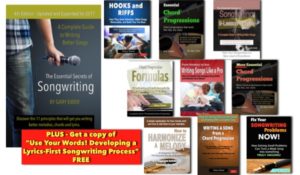There’s an analogy to be found that applies well to songwriting when you look at someone walking: as the right leg moves forward, the left leg moves back. If you haven’t noticed that before, you haven’t been paying attention. 😉
In music, a similar thing happens, though you may have to look a little harder to find it: the notion of opposites working together, like two legs moving in opposite directions to get you moving forward. It’s more commonly known as the contrast principle, and it can be part of the success of a good song.
 Got a melody but can’t figure out how to add chords to it? You need to read “How to Harmonize a Melody.” Complete with sound samples to guide you. Get it separately, or as part of “The Essential Secrets of Songwriting 10-eBook Bundle”
Got a melody but can’t figure out how to add chords to it? You need to read “How to Harmonize a Melody.” Complete with sound samples to guide you. Get it separately, or as part of “The Essential Secrets of Songwriting 10-eBook Bundle”
While in walking something is always moving backward while something moves forward, the opposite directions happen in music but usually at different times: melodies have low points and then, at some later moment, high points. Chord progressions might have minor sections and then major sections. Lyrics are at times narrative, and at other times simply reacting in an emotional way to the story.
That notion of opposites is a vital part of developing musical interest. And audiences come to expect it in a subconscious sort of way. Finding opposites within your songs is a good way to knowing that your music is working well.
So for every song you write, you might run through the following steps:
- Check the melodies for opposites. Verse melodies should dwell in the lower notes of your vocal range. Then in the chorus the opposite happens: the melody should sit higher, and usually displays the song’s highest notes, with often a climactic moment.
- Check the chords for opposites. As one possible approach, verse melodies sound great when there’s a minor sound (i.e., mainly minor chords) that move to a major sound for the chorus. For verse-only songs (or verse-bridge), it can sound good to start major, move toward a kind of minor feel, finishing with major.
- Check the lyrics for opposites. The up and down of emotional expression is common to all songs of any genre. Songs should start narrative and move toward emotional, whether it’s a verse-chorus or verse-bridge formal design.
- Check instrumentation/production for opposites. Changes in the instrumentational sounds you use will pertain mainly to the texture (or thickness) of those sounds. It’s typical to use thinner, more transparent sounds in a verse, and move to fuller, louder sounds in a chorus. For high energy songs, you might use the bridge to calm things down and revert to a lighter accompaniment, but in any case, it’s the toggling between full and transparent that keeps listener interested.
I’ve always loved Imogen Heap’s “Tidal” from her album “Ellipse” as a great song that demonstrates the power of subtle contrasting. Listen to it just thinking about contrast – melodic range, chords, lyrics, overall sound. It’s wonderful.
 Written by Gary Ewer. Follow Gary on Twitter.
Written by Gary Ewer. Follow Gary on Twitter.
Get “The Essential Secrets of Songwriting” eBooks. They’ll help you polish your technique, and make you the best songwriter you can be. Comes with a Study Guide, tons of chord progressions, and information covering every aspect of how to write good music.











